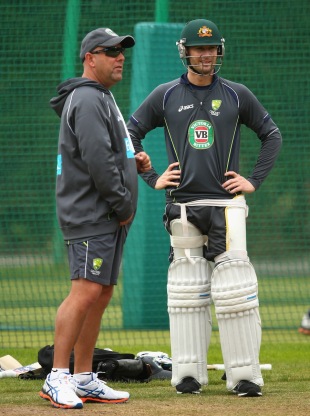Chris Bradshaw in Wisden India
About the only thing that the Rio Casino in Las Vegas has in common with Lord’s is that it attracts a disproportionate number of men with a liking for bright red trousers. Superficially, there’s little in common between the home of the World Series of Poker and cricket’s traditional headquarters. Dig a little deeper though and there is a surprising amount that cricketers, and especially captains, can learn from their poker-playing counterparts.
Richie Benaud famously said: “Captaincy is 90 per cent luck, only 10 per cent skill – but don’t try it without the 10 per cent.” Despite being more of a horse-racing man than a card sharp (Benaud restricts himself to wagers on things that cannot speak), his adage sounds remarkably similar to something written by Doyle Brunson, one of the greatest poker players who has ever lived.
In his best-selling 1978 strategy book Super System: A Course In Power Poker, the two-time World Series of Poker Main Event winner wrote: “Poker is more art than science, that’s what makes it so difficult to master. Knowing what to do – the science – is about 10 per cent of the game. Knowing how to do it – the art – is the other 90 per cent.” Not identical to Benaud’s line but near enough to warrant a closer look.
Poker players loosely fit into two main playing styles. Tight players proceed cautiously and wait for the best hands. Loose players will play with any two cards. Taken to its extreme, a super-tight player would only play a pair of aces while a hyper-loose player would try his luck with anything, even 7-2 off suit, the worst starting hand in Texas hold ’em. Allied to the tight and loose tendencies are levels of aggression. Aggressive players are always on the front foot, looking to attack, while passive players tend to fear losing rather than trying to win.
In the long run, both tight and loose aggressive poker players can be successful. It’s possible, but much harder, for tight passive types to make much money. Loose passive players might as well set fire to their bankroll.
Those tendencies are often clearly visible on the cricket pitch. A tight captain will wait until he has a ridiculous lead before setting a declaration while a looser leader would dangle a carrot. Andrew Strauss was a prime example of a tight, aggressive captain. The commentary box moaners may not have liked his seemingly defensive fields but by employing a sweeper early in the innings – rather than having an extra slip, say – Strauss preferred to retain control rather than speculate. When and only when, the game was in his team’s favour would Strauss go on the attack.
Brendon McCullum, on the other hand, is much more akin to the loose aggressive poker player and willing to have a gamble. If he sets an attacking field and the ball flies through the vacant cover region to the boundary, so what? An unorthodox bowling change may mean conceding a few runs but it might also pick up a wicket. If the rewards are big enough, he’ll follow that hunch even if the results are costly if he’s proved wrong.
The flip side of that aggressive stance can be seen in any number of delayed England declarations and botched run chases. Take the home side’s 2001 capitulation to Pakistan at Old Trafford. Alec Stewart’s side went from tight aggressive to tight passive with disastrous results. With the score at 174 for one and needing another 196 runs from 45 overs for a famous victory, England lost a wicket then shut up shop. Instead of going for the win, they tried not to lose. One session and eight wickets later, Waqar Younis and co had tied the series.
***
The stereotype of the poker player as a fast-talking, cigar-chomping, road gambler is an outdated one. You’re far more likely to see a softly spoken Scandinavian wearing headphones and a hoodie in a top tournament these days rather than a Stetson-wearing Texan. Technology has transformed poker and the statistically-minded are in the ascendancy.
Virtually every professional poker player now uses a database to log every raise, every bet size, every fold, every call, every unexpected all-in move and just about everything else that happens at the online tables. Crunching the numbers to identify opposition weaknesses and their own technical deficiencies has become a crucial weapon for even semi-serious players of the game.
Cricket’s own statistical revolution has mirrored the one undergone by poker. Every delivery is tracked by an analyst, every shot monitored by a specialist coach and every potential technical frailty probed by the team’s brain trust. The captains in the Sky commentary box (what is the collective noun for a group of England captains? A disappointment? A grumble?) may say that a third man should be in place. The figures in black and white suggest otherwise.
Of course it’s all well and good for a team to have a plethora of stats at their disposal, but if they don’t know how to use them it can cause more confusion than clarity. Despite enjoying some recent success, England have been accused of producing teams full of cricketing automatons, unable to think on their feet or adapt in the face of changing circumstances. If the plan discussed in the dressing-room isn’t working, England’s C-3POs have often seemed too rigid to do anything about it. “The stats said we should bounce them out. We’ll carry on bouncing them, even though the ball is disappearing to the boundary twice an over.”
A good captain, like a good poker player, will use the stats but won’t be a slave to them. He will still trust his feel for the game to assess the strengths and weaknesses of his opponent.
The concept of pot odds is also one that is easily transferable to cricket. A poker player may have to pay to chase his straight or flush draw but if the odds are right, it becomes a mathematically correct move to make. It’s a risk, but in the long run the rewards justify taking that chance. Similarly, a bowler might dish up three half volleys, knowing that they’ll likely be despatched through an extra-cover region deliberately left vacant. The fourth delivery, a fraction shorter and a touch wider, gets nicked and is pouched by the slip fielder who could have been patrolling the covers. The bowler may have given up a few extra runs but has been rewarded with a wicket. A good poker player knows when to take a gamble as if he hits his outs, he’ll make a big profit. A cricket captain should be able to do the same.
“Play aggressively, it’s the winning way,” Brunson writes. Being aggressive isn’t a call to suddenly awaken your inner Merv and start mouthing off at the competition. It simply means taking control and dictating terms. “Timid players don’t win in high-stakes poker.” They rarely win at cricket either.
It sounds obvious but the great captains, like the best poker players, are always thinking one move ahead of their opponent. A successful poker player will recognise when to adapt as the conditions of the game alter. The arrival of a deep-stacked, ultra-loose player can completely change the dynamics of a table, just as a big-hitting tail-ender can totally change the momentum in cricket. An intuitive captain will know when to attack and when to hang back and wait for a more profitable opportunity. “Changing gears is one of the most important parts of playing poker. It means shifting from loose to tight play and vice versa,” writes Brunson.

Andrew Strauss was a prime example of a tight, aggressive captain – who would wait until he has a ridiculous lead before setting a declaration. © Getty Images
The same is true of players going on a hot streak and winning a number of pots in quick succession. “Your momentum is clear to all players. On occasions like this you’re going to make correct decisions and your opponents may make errors because they are psychologically affected by your rush.” Brunson could be writing about any captain whose side has inflicted a crippling batting collapse on the opposition.
To succeed, “you’ll need to get inside your opponent’s head,” writes Brunson. In the modern game, there has been no better exponent of this than Shane Warne (just ask poor Daryl Cullinan). Being able to turn a leg-break a yard was famously Warne’s greatest asset. His mastery of the dark arts of mental disintegration helped shape the aura that accompanied him wherever he played though, especially against England. Before every series there was talk of a new mystery delivery. The zooter, the clipper, whatever you want to call it. The new phantom ball rarely appeared but the seed had been planted, the trap set, the bluff laid. And Warne was ready to collect.
Of course a cricket skipper can utilise the team members he has at his disposal while a poker player rides solo. For Steve Waugh, having Shane Warne and Glenn McGrath in his side was like being dealt aces every hand. Aces make you a favourite, but they do get cracked if they’re not handled properly. Poker players are dealt duff hands most of the time. The best players get the best out of what they’ve been given.
Even though he’s now in his eighties, Brunson still manages to play in some of the biggest cash games around, with thousands of dollars at stake. Successful “old-school” players have welcomed the way the game has changed and adapted accordingly (you won’t hear a Truemanesque “I don’t know what’s going off out there” from Brunson). Like cricketing tactics, poker techniques have evolved over time. If Brunson played the same way now as he did when he won his first world title in 1976 he’d be eaten alive by the twentysomething maths geeks. The basic philosophies outlined in Super System still hold true though. The precise tactics may have changed but the instincts that served him so well at the start of his career continue to do so today.
The poker world these days is peppered with current and former sporting greats. Footballers Tony Cascarino and Teddy Sheringham have earned six-figure paydays on the tournament circuit. Rafa Nadal and Boris Becker act as ambassadors for a major online poker site. Given the storm surrounding match-rigging and spot-fixing, it’s probably understandable that most cricketers have steered clear. The obvious exception is Shane Warne, who regularly clears a couple of weeks from his commentary schedule to play at the World Series of Poker.
In a brief stint as captain of Australia’s one-day side Warne enjoyed great success, winning 10 out of 11 matches. The same formula brought IPL glory to the Rajasthan Royals and promotion and one-day success to Hampshire.
Ian Chappell once wrote that the leg-spinner who most resembled Warne was the feisty Australian Bill “Tiger” O’Reilly, a man who openly hated batsmen. “He thought they were trying to take the food out of his mouth and consequently he was ultra-aggressive in his efforts to rid himself of the competition,” wrote Chappell. “Warne had a similar thought process and he was constantly plotting the batsman’s downfall.” Sounds like ideal card-room strategy. It’s no wonder Warne’s now a pretty good poker player.
Mike Brearley’s The Art of Captaincy is usually the first book off the shelf for budding skippers. Potential leaders could do worse than making Super System their second.






